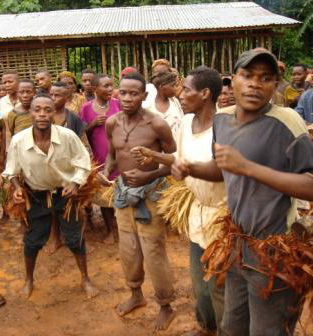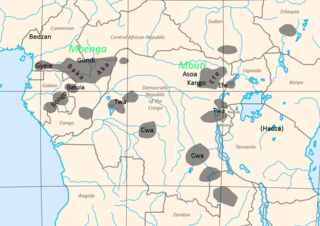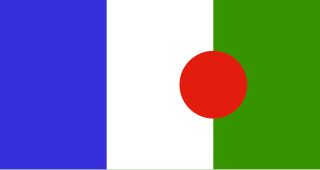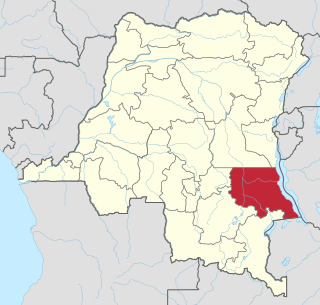Related Research Articles

In anthropology, pygmy peoples are ethnic groups whose average height is unusually short. The term pygmyism is used to describe the phenotype of endemic short stature for populations in which adult men are on average less than 150 cm tall.

The Mbuti people, or Bambuti, are one of several indigenous pygmy groups in the Congo region of Africa. Their languages are Central Sudanic languages and Bantu languages.

The Aka or Biaka are a nomadic Mbenga pygmy people. They live in south-western Central African Republic and in northern Republic of the Congo. They are related to the Baka people of Cameroon, Gabon, northern Congo, and southwestern Central African Republic.

The Baka people, known in the Congo as Bayaka, are an ethnic group inhabiting the southeastern rain forests of Cameroon, northern Republic of the Congo, northern Gabon, and southwestern Central African Republic. They are sometimes called a subgroup of the Twa, but the two peoples are not closely related. Likewise, the name "Baka" is sometimes mistakenly applied to other peoples of the area who, like the Baka and Twa, have been historically called pygmies, a term that is now considered derogatory.
The Efé are a group of part-time hunter-gatherer people living in the Ituri Rainforest of the Democratic Republic of Congo. In the depths of the forest they do not wear much clothing, using only leaf huts as shelter for their bodies in the intense heat. The Efé are Pygmies, and one of the shortest peoples in the world. The men grow to an average height of 142 cm, and women tend to be about 5 cm shorter.

Basankusu is a town in Équateur Province, Democratic Republic of the Congo. It is the main town and administrative centre of the Basankusu Territory. In 2004, it had an estimated population of 23,764. It has a gravel airstrip, covered and open markets, a hospital, and three cellphone networks, the first of which was installed in 2006. The town is also known as a centre for bonobo conservation efforts. Despite such developments, most inhabitants live at a subsistence level: hunting, fishing, keeping chickens and keeping a vegetable plot. In 2010, the workers at the local palm plantation would earn an average monthly salary of $40, most others would have much less.
The Roman Catholic Diocese of Wamba is a diocese located in the city of Wamba in the ecclesiastical province of Kisangani in the Democratic Republic of the Congo. Apparently, during the tenure of Bishop Kataka Lucete, there were 18 parishes and 42 diocesan priests.
Lese is a Central Sudanic language of northeastern Democratic Republic of the Congo, as well as a name for the people who speak this language. The Lese people, live in association with the Efé Pygmies and share their language, which is occasionally known as Lissi or Efe.
Budu (Ɨbʉdhʉ) is a Bantu language spoken by the Budu people in the Wamba Territory in the Orientale Province of the Democratic Republic of the Congo. Its orthography uses the special characters ɨ, ʉ, ɛ and ɔ, as well as modifier letters colon ꞉ and equal sign ꞊ for grammatical tone, marking past and future tense, respectively.
Bila, or Forest Bira, is a Bantu language spoken in the Mambasa Territory of the Democratic Republic of Congo. It is also spoken by the Mbuti Pygmies who live in that area. Pygmy groups to the west include the Kango and Sua (Batchua). Other Mbuti speak Central Sudanic languages. The Kango and Sua speak distinct dialects, but not enough to impair mutual intelligibility with their farming Bila patrons.
The Kango (Bakango), also known as the Batchua and Mbuti-Sua, are an Mbuti pygmy people of the Ituri forest. They speak a Bantu language, Bila, apparently in two dialects, northern Sua and southern Kango.

The term Congo Pygmies refers to "forest people" who have, or recently had, a hunter-gatherer economy and a simple, non-hierarchical societal structure based on bands, are of short stature, have a deep cultural and religious affinity with the Congo forest and live in a generally subservient relationship with agricultural "patrons", with which they trade forest products such as meat and honey for agricultural and iron products.

The Twa are a group of indigenous Central African foragers tribes. These cultural groups were formerly called Pygmies by European writers, but the term is no longer preferred based on its cultural and geographic inaccuracy, as well as being seen as pejorative. Cultural groups are being reclassified by themselves based on their function in society, lineage, and land ties.

The Great Lakes Twa, also known as Batwa, Abatwa or Ge-Sera, are a Bantu speaking group native to the African Great Lakes region on the border of Central and East Africa. As an indigenous pygmy people, the Twa are generally assumed to be the oldest surviving population of the Great Lakes region. Current populations of Great Lakes Twa people live in the states of Rwanda, Burundi, Uganda and the eastern portion of the Democratic Republic of Congo. In 2000 they numbered approximately 80,000 people, making them a significant minority group in these countries. The largest population of Twa is located in Burundi estimated in 2008 at 78,071 people.
The Turumbu people live in the Democratic Republic of the Congo, mostly in the Isangi Territory of the Tshopo District on both sides of the Congo River. They speak the Lombo language. As of 1971 their population was estimated to be 10,000. A more recent estimate put the population at 32,000.
Nia Nia is a village in the extreme west of Mambasa territory of Ituri province in the Democratic Republic of the Congo. It is in the center of the Okapi Wildlife Reserve, a rich area of tropical rainforest, and can be reached only via roads that are often impassable throughout the rainy season. Most of the local population belongs to the Ndaka people of the Mambasa Territory or the Budu people of the Wamba Territory. Colonial mines produced gold in this area from the 1920s until 1958. As of 2011 Kilo Goldmines, a Canadian company, was active in a joint venture with Somituri sprl, a local company, in exploiting properties in the Mambasa and Wamba territories near the village of Nia Nia.
The Ngando people are Bantu subsistence farmers who live in eastern part of Équateur and the western part of Orientale province in the Democratic Republic of the Congo.
The Nepoko River is a river in the Democratic Republic of the Congo. It joins the Ituri River at the town of Bomili to form the Aruwimi River.

The African Pygmies are a group of ethnicities native to Central Africa, mostly the Congo Basin, traditionally subsisting on a forager and hunter-gatherer lifestyle. They are divided into three roughly geographic groups:

The Batwa–Luba clashes were a series of clashes in the Democratic Republic of the Congo (DRC) between the Pygmy Batwa people, and the Luba people that began in 2013 and ended in 2018.
References
- 1 2 3 "Budu of Congo, Democratic Republic of". Joshua Project. Retrieved 2011-10-25.
- ↑ "Budu: A language of Democratic Republic of the Congo". Ethnologue. Retrieved 2011-10-25.
- 1 2 3 "THE BUDU NITA FILM TEAM OF THE DEMOCRATIC REPUBLIC OF CONGO" (PDF). The JESUS Film Project. July 2010. Archived from the original (PDF) on 2012-04-25. Retrieved 2011-10-25.
- ↑ Giuseppe M. Carpaneto & Francesco P. Germi (1983). "The mammals in the zoological culture of the Mbuti Pygmies in north-eastern Zair". Hystrix. 1: 1–83. Archived from the original on 2012-03-31. Retrieved 2011-10-25.